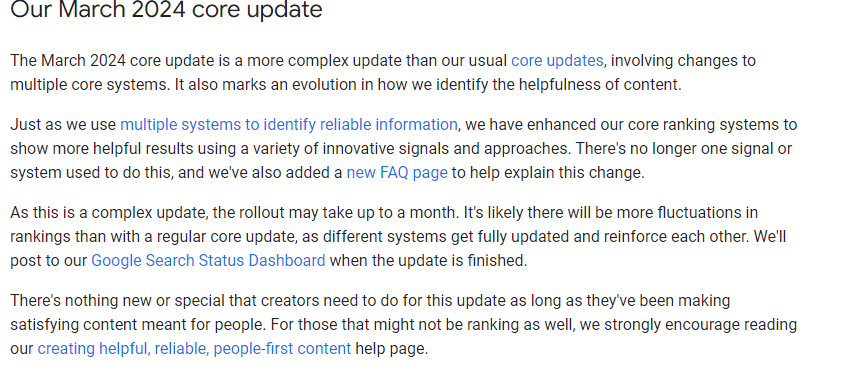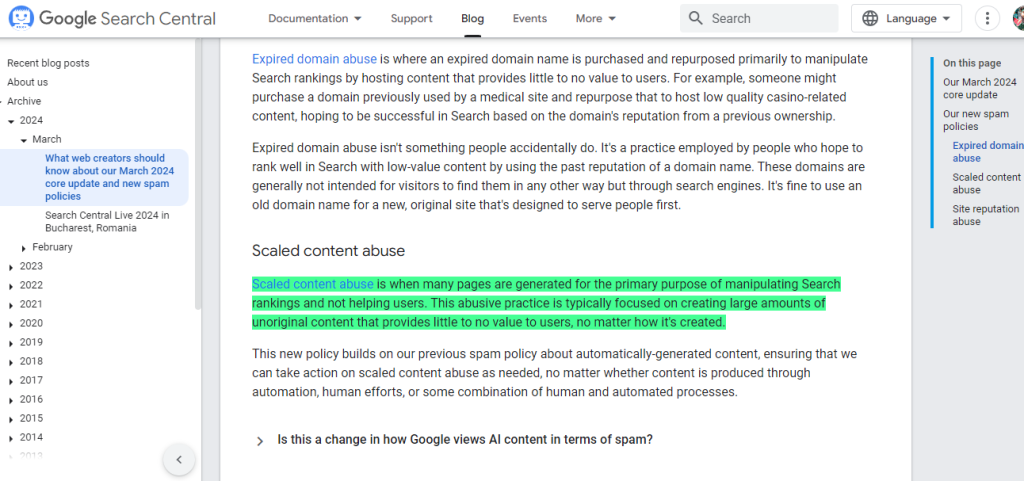Gone are the days when writers could easily rank their blogs on the top of the search engine result pages. The tendency to force keywords in different places in the content, implement some basic SEO strategies, and increase the length of the blogs with useless lines don’t work today.
Why Should You Write SEO Articles?
Search engines like Google have become way more optimistic these days, and this is valid as user-friendly, helpful content is the utmost priority. The latest 2024 March Core Update rewards some blogs, but most bloggers around the world are still unsure how to recover their websites.

Do you know why most articles lose their position after every algorithm update?
Well, bloggers just want to rank their articles. In terms of offering value to the audience, they still need to catch up, and Google is well aware of this. With a good SEO strategy and helpful content, you can outperform your articles and drive good traffic.
The importance of SEO-friendly articles can’t be described within a few words. If you are on a mission to rank your web pages, writing compelling SEO articles is something you should not underestimate.
Ways To Write SEO-Friendly Articles
1. Know Your Audience
I’m sorry, but you can’t write proper SEO-friendly content unless you clearly know who will read it. Beyond that, how can you better add value to your content if you don’t know the search intent? So, taking time to determine to whom you write content is the best thing you can do. Regardless of your niche, the more you know your targeted audience, the better your reach will be.
2. Research keywords Like a Pro
Let’s assume you have figured out who your articles are for. Now, it’s time to settle down and figure out how to reach that group of people. And here is where you need proper keyword research. An in-depth keyword research strategy is required to put your content in front of the right audience.
But how do you do that?
- Step 1: Bring some head keywords to your mind. These are single words based on your niche. However, you should not target this type of keyword as the intent is unclear and competition is higher. Hang on; these keywords are going to come into play.
- Step 2: Search on Google using the head keywords. Once you do that, you will see other relevant keywords below. Make sure you always choose long-tail keywords with lower competition. This will increase the chance of ranking your articles higher on the search engine result pages.
“Long-tail keywords get less search traffic but usually have a higher conversion value, as they are more specific.”
- Step 3: Use keyword research tools. Fortunately, both free and paid keyword research tools can help you choose the keyword better. Going with Google Keyword Planner is always the best option for beginners. However, some paid tools like Ahref, Semrush, and Moz offer free versions with some limitations.
3. Write Engaging Content
Now that you have the keywords in mind, it’s time to write helpful content for your audience. This is where most bloggers mess up. However, you should take the time to determine what you will establish with your articles and how you can better present them to add value to your audience.
The content should contain valid information, your personal experience, proper citations, and helpful resources. This is where you need to establish EAT: expertise, authoritativeness, and trustworthiness. Otherwise, you may rank your articles, but it will be like a roller coaster ride, and ultimately, the content will be nowhere.
At the same time, write articles that seem scannable because readers don’t have time to read your content line by line. According to Time Magazine, 55% of visitors spend less than 15 seconds on web pages. For this, make sure to put the right images, videos, infographics, and other content.

As you can see, your website may even be penalized if you do not write content that helps the reader or your audience. And you can predict whether the articles will rank!
Here are the things you should check;
- Write attention-grabbing headlines.
- Hook your readers with compelling intros.
- Insert relevant tables, bullet points, and quotes in your articles.
- Break down the paragraphs into 2-3 lines.
- Use an active voice more often.
4. Optimize Your Articles
Writing articles randomly will not provide any real value unless you optimize them. But the question is, how do you do that? Is putting keywords in the headings and subheadings enough? No! It is always better to write and optimize your content for SEO at the same time.
Let’s make things a bit simple here. It will be better if I let you know how you can optimize your article for keywords, right? No, I am not supposed to do that because if your article matches the search intent, more than half of the optimization is done.
So, what am I trying to establish? You could trick Google by squeezing your targeted keywords many times in your content 15 years ago. But not now.

The article is ranked for the keywords ‘How to learn SEO,’ But the exact keyword is not mentioned at least once in the content. This is the case for 70% of the web pages that rank in the top 10 in search result pages.
Now, let’s have a glance at what you should do;
- Put your targeted keywords in the URLs, titles, headings, and content.
- Use secondary keywords in the body section.
- The length of the title should be 50-60 characters.
- Write a meta description within 50-160 characters.
- Optimize the images you use in your articles (fill out the alt-image text field). The images should also be effectively described so that the algorithm finds them helpful.
- Optimize images for Google featured snippets. This will allow you to show the part of your article directly in the feature snippet section in SERPs.
5. Check Your Content Before Hitting the Publish Button
After creating the ugly first draft, you should take your time to double-check the content. To be more precise, ensure there are hardly any grammatical errors, the sentences don’t look robotic, and everything is in perfect shape. You can use Grammarly or any other tool to check for grammatical errors and then fix them.
Conclusion
Writing an SEO-friendly article takes time. But you should bother with the time and effort, as you will have a greater output. It always feels good seeing our articles rank higher on the SERPs and even better when we can produce helpful content for our audience.